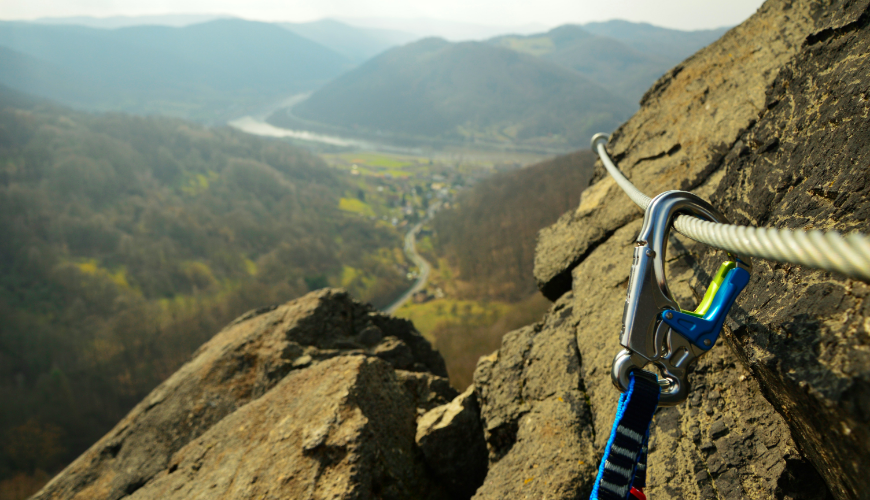If you’re an adventure enthusiast looking for a new thrill, via ferrata might be just what you need. This exciting activity combines the best of rock climbing and hiking, offering a unique and accessible way to experience the great outdoors. But what exactly is via ferrata? Let’s explore this fascinating sport, its history, and what you need to know to get started.
The term “via ferrata” is Italian for “iron path.” It refers to a protected climbing route found in the mountains, which is equipped with fixed anchors like steel cables, rungs, ladders, and bridges. These aids help climbers navigate through rocky terrains safely. Via ferrata allows people with varying levels of climbing experience to enjoy the beauty of mountainous landscapes without the need for advanced climbing skills.
The origins of via ferrata date back to the late 19th century, but it became more widespread during World War I. Soldiers in the Italian Dolomites used these routes to move troops and supplies across difficult mountain terrain. After the war, the concept of via ferrata continued to develop, becoming popular among climbers and hikers looking for a new way to explore the mountains.
Equipment and Safety
One of the key aspects of via ferrata is safety. The fixed cables and anchors are designed to keep climbers secure. However, proper equipment is still essential. Here are the basic items you’ll need:
When embarking on a via ferrata adventure, having the right equipment is essential for safety and enjoyment. A helmet is crucial as it protects your head from falling rocks and other potential hazards encountered along the route. Equally important is a harness, which secures you to the safety system, ensuring that you remain attached to the fixed cables and anchors at all times. The via ferrata set, a specialized kit, includes a lanyard with two carabiners and an energy absorber designed to reduce the impact in case of a fall, providing an added layer of security. Additionally, wearing gloves is advisable as they protect your hands from rough rocks and metal, making it easier to grip and maneuver along the iron path. Each piece of equipment plays a vital role in ensuring that your via ferrata experience is both safe and enjoyable.
Using the right equipment and following safety guidelines are crucial to enjoying via ferrata safely.
Types of Routes
Via ferrata routes vary in difficulty, making it important to choose one that matches your skill level. They are typically graded based on their technical difficulty, exposure, and physical demands. Here are some common grading systems:
- French System: Grades from F (Facile/Easy) to ED (Extrêmement Difficile/Extremely Difficult).
- Italian System: Uses a similar grading scale with additional descriptions.
- German System: Uses a K-rating, with K1 being the easiest and K5 the most challenging.
Beginners should start with easier routes and gradually progress to more difficult ones as they gain experience.
Popular Via Ferrata Destinations
Via ferrata routes can be found all over the world, each offering unique landscapes and challenges. Some of the most popular destinations include:
The Dolomites in Italy are considered the birthplace of via ferrata, featuring numerous routes that cater to varying levels of difficulty. This region is famous for its dramatic rock formations and historical significance, making it a top destination for adventure enthusiasts.
https://via-ferrata-dolomites.com
The French Alps are another prime location for via ferrata, offering many scenic and well-equipped routes. The breathtaking views and challenging climbs attract climbers from all over the world, providing an unforgettable experience in the heart of the mountains.
https://www.ultimatefrance.com/via-ferrata/french-alps
In the Austrian Alps, climbers can enjoy stunning views and a diverse range of via ferrata routes. This area is known for its picturesque landscapes and well-maintained trails, making it a favorite among both beginners and experienced climbers.
https://www.outdooractive.com/en/via-ferratas/austria/via-ferratas-in-austria/1467371/
The Rocky Mountains in the USA also offer a variety of via ferrata experiences in a rugged and beautiful landscape. These routes provide adventurers with unique challenges and the opportunity to explore one of North America’s most iconic mountain ranges.
https://estes-park.com/outdoor-adventure/estes-park-and-colorado-via-ferratas/
These locations attract adventurers from around the globe, eager to test their skills and enjoy breathtaking views.
Getting Started
If you’re interested in trying via ferrata, here are some steps to get you started:
- Research – Learn about different routes and choose one suitable for your skill level.
- Join a Group or Hire a Guide- Especially if you’re a beginner, joining an organized group or hiring a guide can enhance your safety and enjoyment.
- Take a Course – Many outdoor centers offer via ferrata courses to teach the basics of equipment use and safety.
- Practice – Start with easier routes to build your confidence and skills before tackling more challenging ones.
Via ferrata offers a unique and exhilarating way to explore the mountains. With the right equipment, preparation, and respect for safety guidelines, climbers of all levels can enjoy this sport. Whether you’re scaling the rugged cliffs of the Dolomites or navigating the scenic routes of the French Alps, via ferrata promises an adventure like no other. So gear up, clip in, and get ready to discover the thrilling world of via ferrata!






